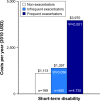COPD affects worker productivity and health care costs
- PMID: 30104870
- PMCID: PMC6072680
- DOI: 10.2147/COPD.S163795
COPD affects worker productivity and health care costs
Abstract
Purpose: This study aimed to measure the true burden of COPD by calculating incremental direct and indirect costs. Direct medical resource use, productivity metrics, and COPD-specific resource use and costs were also evaluated.
Patients and methods: This was a retrospective, observational, matched cohort study using administrative claims data from the Truven Health MarketScan® Commercial Claims and Encounters and the Health and Productivity Management databases (2007-2010). Working-age (18-65 years) patients with COPD were identified as having at least one hospitalization or one emergency department visit or two outpatient visits. Patients in the non-COPD cohort did not have a diagnosis of COPD during the study period. Outcomes were evaluated in the first full calendar year after the year of identification (index).
Results: Of the 5,701 patients with COPD identified, 3.6% patients were frequent exacerbators (≥2), 10.4% patients were infrequent exacerbators (1), and 86% patients were non-exacerbators (0). When compared with the 17,103 patients without COPD, the incremental direct cost of COPD was estimated at $6,246/patient/year (95% confidence interval: $4,620, $8,623; P<0.001). Loss in productivity was significantly greater in patients with COPD, with an average of 5 more days/year of absence from work and incremental indirect costs from short-term disability of $641 (P<0.001). Direct costs for frequent exacerbators ($17,651/year) and infrequent exacerbators ($14,501/year) were significantly higher than those for non-exacerbators ($11,395, P<0.001).
Conclusion: Working-age patients with COPD incur statistically significantly higher direct and indirect costs and use more resources compared with those who do not have COPD.
Keywords: COPD; cost; employer; exacerbation; productivity; resource.
Conflict of interest statement
Disclosure JGP and AAD were employees of GSK at the time of the study conduct. JGP is currently an employee of Amgen and owns stocks/shares. AAD is currently an employee of Novartis Pharmaceuticals and owns stocks/shares. ADC and OEL are employees of Xcenda, a health care consulting company contracted by GSK for the conduct of this study. The authors report no other conflicts of interest in this work.
Figures



Similar articles
-
Impact of COPD Exacerbation Frequency on Costs for a Managed Care Population.J Manag Care Spec Pharm. 2015 Jul;21(7):575-83. doi: 10.18553/jmcp.2015.21.7.575. J Manag Care Spec Pharm. 2015. PMID: 26108382 Free PMC article.
-
Burden of chronic obstructive pulmonary disease in Medicare beneficiaries residing in long-term care facilities.Am J Geriatr Pharmacother. 2009 Oct;7(5):262-70. doi: 10.1016/j.amjopharm.2009.11.003. Am J Geriatr Pharmacother. 2009. PMID: 19948302
-
Economic Burden of COPD in the Presence of Comorbidities.Chest. 2015 Jul;148(1):138-150. doi: 10.1378/chest.14-2434. Chest. 2015. PMID: 25675282 Free PMC article.
-
Indirect costs in chronic obstructive pulmonary disease: a review of the economic burden on employers and individuals in the United States.Int J Chron Obstruct Pulmon Dis. 2014 Mar 19;9:289-300. doi: 10.2147/COPD.S57157. eCollection 2014. Int J Chron Obstruct Pulmon Dis. 2014. PMID: 24672234 Free PMC article. Review.
-
Economic Burden of Chronic Obstructive Pulmonary Disease (COPD): A Systematic Literature Review.Int J Chron Obstruct Pulmon Dis. 2020 Feb 26;15:439-460. doi: 10.2147/COPD.S234942. eCollection 2020. Int J Chron Obstruct Pulmon Dis. 2020. PMID: 32161455 Free PMC article.
Cited by
-
The Impact of Exacerbation Frequency on Clinical and Economic Outcomes in Swedish COPD Patients: The ARCTIC Study.Int J Chron Obstruct Pulmon Dis. 2021 Mar 18;16:701-713. doi: 10.2147/COPD.S297943. eCollection 2021. Int J Chron Obstruct Pulmon Dis. 2021. PMID: 33776429 Free PMC article.
-
Factors affecting work productivity and activity impairment among chronic obstructive pulmonary disease patients.Ind Health. 2024 Feb 9;62(1):20-31. doi: 10.2486/indhealth.2022-0174. Epub 2023 Apr 21. Ind Health. 2024. PMID: 37081622 Free PMC article.
-
Clinical Impact and Cost-Effectiveness of Updated 2023/24 COVID-19 mRNA Vaccination in High-Risk Populations in the United States.Infect Dis Ther. 2025 Jun;14(6):1219-1238. doi: 10.1007/s40121-025-01128-z. Epub 2025 Apr 15. Infect Dis Ther. 2025. PMID: 40232338 Free PMC article.
-
Disease Burden and Health-Related Quality of Life (HRQoL) of Chronic Obstructive Pulmonary Disease (COPD) in the US - Evidence from the Medical Expenditure Panel Survey (MEPS) from 2016-2019.Int J Chron Obstruct Pulmon Dis. 2024 May 13;19:1033-1046. doi: 10.2147/COPD.S446696. eCollection 2024. Int J Chron Obstruct Pulmon Dis. 2024. PMID: 38765766 Free PMC article.
-
PROMETHEUS: Long-Term Exacerbation and Mortality Benefits of Implementing Single-Inhaler Triple Therapy in the US COPD Population.J Health Econ Outcomes Res. 2023 Jan 24;10(1):20-27. doi: 10.36469/001c.55635. eCollection 2023. J Health Econ Outcomes Res. 2023. PMID: 36742194 Free PMC article.
References
-
- Global Initiative for Chronic Obstructive Lung Disease Global Strategy for the Diagnosis, Management and Prevention of Chronic Obstructive Pulmonary Disease. 2018. [Accessed April 27, 2018]. Available from: http://goldcopd.org/wp-content/uploads/2017/11/GOLD-2018-v6.0-FINAL-revi.... - PubMed
-
- National Heart Lung and Blood Institute Morbidity and Mortality: 2009 Chart Book on Cardiovascular, Lung and Blood Diseases. 2009. [Accessed May 16, 2018]. Available from: https://ecopmc.files.wordpress.com/2012/04/2009_chart-book.pdf.
-
- Report MC. Chronic Obstructive Pulmonary Disease (COPD): An Actuarial Analysis of Drug Therapy Treatment Patterns for a Commercially Insured Population. 2011. [Accessed June 21, 2013]. Available from: http://www.milliman.com/uploadedFiles/insight/research/health-rr/chronic....
Publication types
MeSH terms
LinkOut - more resources
Full Text Sources
Other Literature Sources
Medical

